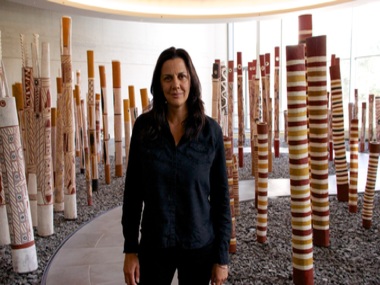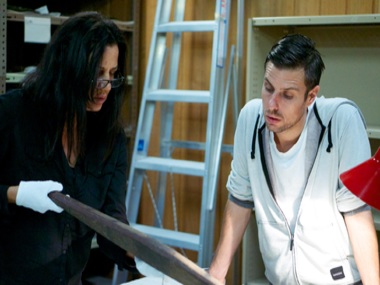ART IS THE VOICE OF OUR PEOPLE

Presenter Hetti Perkins amongst the Aboriginal Memorial Poles at the National Gallery in Canberra
Jeremy Eccles | 08.07.14
Author: j
News source: Review
Publication date: 20140708000000
So, Hetti Perkins is back with us, refreshed from a sabbatical period post-Art Gallery of NSW, where she used to be the first, and so far only, senior curator of Aboriginal Art. I wonder why they think they can manage without filling such a team-leading role?
In Perkins's first TV series of Art+Soul in 2010, she declared she'd been reluctantly 'forced' into the presenter role as she filmed her artist friends in their homes, studios or Country from Melbourne to Kintore. With the brilliant assistance of director/cinematographer, Warwick Thornton – then on the crest of his Samson & Delilah wave, now also a conceptual artist himself featuring in the series – she managed to overcome her shyness; though arguably, she was limited by the time available to shoot which encouraged her to portray only art with which she was already familiar, and by a sense of needing to pack as much as possible into the three programs. I think she covered 25 artists.
Now, in series two which begins on the ABC tonight, we're getting much more meat with each artist on the basis of my previewing the first episode, in which just four artists are engaged. And much more politics. And more of a more confident Hetti.
But then, how we could we not have politics from the daughter of the late Charlie Perkins – who makes his presence felt at the start through imagery and a repeat from the first series of the key quote:”We know we cannot live in the past, but the past lives in us”. And who could be a better exemplar of that than that delightful, gentle artist Daniel Boyd. For much of his work – such as the recent Bulgari Prize-winning work at the AGNSW – starts with ancestral photography and research into his Vanuatu/Aboriginal history at places such as London's Natural History Museum.
Can you believe that it holds 30,000 skulls in its basement, many of Australian Aboriginal people in what's called its 'First Fleet Collection'. You can see just where the infamous categorisation of Indigenous Australians amongst the country's 'flora and fauna' – not to mention the Prime Minister's unfortunate slip recently in referring to the Great Southland as “unsettled” - arose from!
Not that it's easy to see the unexplained connection between Boyd's distinctive blackened and glue-stick-dotted canvases and those of Albert Namatjira, “the full-blood Aboriginal man who was such a hero of my childhood”. And sadly, Boyd then discouraged deeper examination of his unique art-making style by putting his techniques firmly into the 'secret/sacred' basket. All that emerged was the importance of charcoal in the initial stages, and the key influence of his associations with the Yarrabah Mission in northern Queensland.
It's the intrinsic politics in work such as Boyd's, which doesn't read like a baldly angry text from Brisbane's proppaNOW mob, that justifies Perkins's discussions – you couldn't call them interviews - with urban artists like him and Sydney's Jonathan Jones. With Jones, she elicits the great quote: “We can't be the world's oldest living culture by standing still. We must have constantly been coming up with new ideas to survive”.
And indeed he's been doing just that with his light-works – many emulating the patterns of tree-carving and battle shields, though we are also introduced to Jones's brilliant moving shark mural in lights, commissioned by Sydney's Star Casino. For the past does live in his very contemporary work - images invariably presented in groups not singly, for they also represent traditional families, tribes and even the patterns of carved trees in the landscape. A researcher like Boyd, though, Jones found that too many of those significant carved trees were cut down in their proper setting and carted off to museums in the 19th Century by acquisitive curators. A lovely Jones artwork captures the bleak stumps left behind.
There's as much politics in Arnhemland art as there is down south. But Perkins finds it easier to put it in words and historic images rather than teasing it out of today's art with an artist such as Wanyubui Marika. This young descendant of such legendary names as Mawalan 1, Mathaman, Milirrpum (his father) and Wandjuk Marika has proudly taken on the clan responsibilities. This has included development of their Gangan outstation, teaching and council work, and he only entered the Yolngu art centre, Buku Larrnggay because it was on his clan land and therefore justified his support. But he's turned out to be a major artistic figure, especially in the telling of the Djang'kawu story, involving the sisters who founded the Rirratjingu clan in their mythology.
In 2009, a major art exhibition was built around the Marika family's interpretation of this matriarchal legend. Yet Perkins barely touches such matters of intrinsic importance to Wanyubi's life and art, even as they're standing beside his two sculptures of the Djang'kawu Sisters – unique as far as know in the otherwise painted iconography of the story.
Is Art+Soul 2, then, a series primarily about Indigenous art – as might be suggested by the National Gallery of Australia's co-production credit - or is it more about the Blak politics that proudly proclaim,”We have survived” in your white world without really wanting to examine the ceremonial basis of tribal life that permitted the survival of a civilisation for 40,000+ years earlier? Standing amongst the 200 lorrkon that make up the Aboriginal Memorial at the National Gallery, Perkins presents them solely as markers of Aboriginal deaths during 200 years of white colonisation. Nothing about the lorrkon's role in Arnhem society or the art inscribed upon them. But, as Wanyubi's fellow-Yolngu, Djambawa Marawili has frequently pointed out of late, it's essentially from ceremony that art, dance and music arises.
We shall see as the series progresses. Certainly Hetti Perkins feels right at home with the Timbery clan of Laper (La Perouse to the uncolloquial) – passing their shell based art on from generation to generation of resilient women and delighting viewers with their sugary take on the Harbour Bridge, Opera House, fairy slippers, etc. I note that Lola Greeno's more historical shell art from Tasmania will feature in a later program – which is great - along with a pioneering foray by Perkins into the remote APY Lands to visit the significant Tjala Art Centre.
Share this:
»  del.icio.us
»
del.icio.us
»  Digg it
»
Digg it
»  reddit
»
reddit
»  Google
»
Google
»  StumbleUpon
»
StumbleUpon
»  Technorati
»
Technorati
»  Facebook
Facebook
Contact Details

Artist Jonathon Jones in conversation with Hetti Perkins

Yolngu artist, Wanyubi Marika with feathers to attach to his sculptures and poles
Further Research
Artists: Albert Namatjira | Warwick Thornton | Daniel Boyd | Djambawa Marawili | Jonathan Jones | Lola Greeno | Wandjuk Marika
News Tags: ABC TV | Art+Soul | Charlie Perkins | Hetti Perkins | Jeremy Eccles
News Categories: Event | Feature | Industry | Media | News | Other Event
News Archive
- 11.10.17 | RETURN OF MUNGO MAN
- 10.10.17 | TARNANTHI 2017
- 11.08.17 | Natsiaas 2017
- 08.08.17 | ABORIGINAL ART ECONOMICS
- 02.08.17 | SCHOLL'S NEXT MOVE
- 20.07.17 | APY ART DOMINATES THE WYNNE
- 17.07.17 | Anangu Artist Wins $100,000 Prize
- 14.07.17 | The End of AAMU
- 13.07.17 | YOU ARE HERE
- 11.07.17 | ART ACROSS THE COUNTRY
- 11.07.17 | TARNANTHI IN OCTOBER
- 05.07.17 | TJUNGUṈUTJA - from having come together
- 02.07.17 | BENNELONG
- 27.06.17 | JIMMY CHI
- 23.06.17 | Blak Markets at Barangaroo
Advertising

